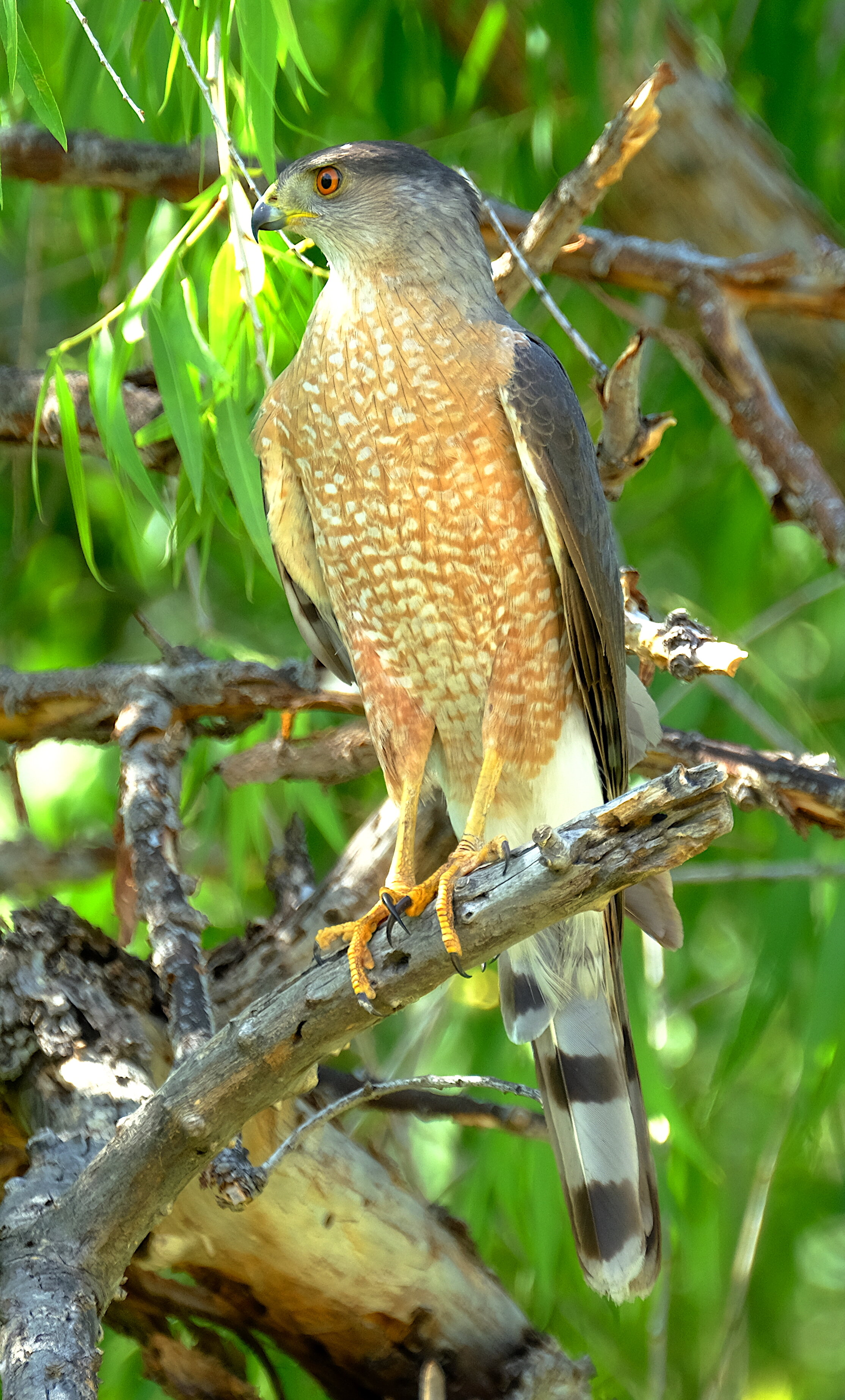Cooper's Hawk
Cooper’s Hawk
by Dave Zittin
The Cooper's Hawk is a member of the genus Accipiter, a group of hawks that have short, broad wings and long tails that are adapted for fast flight in wooded areas. They have fantastic maneuverability in high-speed flight pursuits of prey. They maneuver through trees, brush and around other obstacles with remarkable agility. To protect themselves after capturing prey with their sharp, long talons they hold the captured prey away from their body until it dies. Sometimes these hawks will drown their prey.
Cooper’s Hawks are usually found in deciduous and mixed deciduous forest, but this species has proven to be adaptable to life in urban, suburban and agricultural environments. They are probably the most common backyard raptor in the United States.
This hawk was named by Charles Bonaparte after a friend and fellow ornithologist, William Cooper in 1828.
Cooper’s Hawk by Dave Zittin.
Backyard Cooper’s Hawks
Bird feeders attract Cooper's Hawks. If you have large numbers of birds feeding in your backyard you will likely attract this hawk which kills and eats Mourning Doves, Robins, Jays and more. Their preferred prey are birds of small to medium size, but they will capture and eat small mammals too. We have observed several Mourning Dove kills by Cooper's Hawks in our backyard. Birds will instantly leave a feeding area in rapid flight and disappear as if by magic if they sense a Cooper's Hawk is nearby. If you want to get rid of a Cooper's Hawk that has taken up residence in your backyard, remove your feeders for a few days and it will likely go elsewhere.
Cooper’s Hawk at bird bath. Photo by Myron Meier.
Description
Cooper's Hawks are crow-sized. This species is characterized by short, rounded wings and relatively long tail, which has a rounded end. Their legs are yellow. The adult has a beautiful barred, rufous-colored breast.
The male is smaller than the female. The length of the female ranges from 14.6 to 15.3 inches, about 10 – 20% longer than the male. The male weight range is 7.8 to 14.5 ounces. The heavier female has a weight range of 11.6 to 24.0 ounces.
The young bird resembles the adult in shape, but the back is browner in color, often with white checkering that is absent in the adult and it has brown streaking on its breast. Some of the streaks have a distinctive teardrop shape. The color of the iris of a young bird is yellow and turns orange to red in color as the bird matures.
Juvenile Cooper’s Hawk with Mourning Dove. Note the teardrop shape of the breast streaking and yellow iris. Photo by Dave Zittin]
Distribution
Cooper's Hawks are found across the entire continental United States and south into Central America throughout the year. In the breeding season some adults migrate north into Southern Canada. Non breeding populations occur across most of Mexico and south into Central America throughout the year.
Similar Species
The less common Accipiter species in Santa Clara County is the Sharp-shinned Hawk. Cooper's and Sharp-shinned Hawks are very similar in appearance and present an identification challenge, but with experience, one can distinguish the two.
Sharp-shinned Hawk by Dave Zittin
On roosting birds note the head shape. The Cooper's Hawk's head appears squared off with the top of the head flattened and a distinct almost 90 degree angle forming between the top of the head and back of the neck. The Sharp-shinned has a more rounded head with a continuous arc starting at the upper mandible (beak) continuing over the head and down the nape. The Sharp-shinned Hawk has a relatively smaller head and sometimes appears to lack a neck. The adult Cooper's Hawk has a very dark cap that ends at the angle between the top of the head and neck which presents a sharp color contrast between the top of the head and the lighter nape. While the color of the top of the head of the Sharp-shinned Hawk's head is dark, it continues down onto the nape with no change in color.
Cooper’s Hawk with flat head and sharp angle from top of head onto nape. Photo by Dave Zittin.
Sharp-shinned Hawk with curved head, short neck and dark cap extending onto nape. Photo by Dave Zittin.
In flight the head of a Sharp-shinned Hawk rarely extends beyond an imaginary line from wrist-tip to wrist-tip, but the head of the Cooper's Hawk extends well beyond the leading edges of the wings.
If you see a squared tail end, it's probably a Sharp-shinned Hawk. If you see a rounded tail end it might be a Cooper's or a Sharp-shinned Hawk as the Sharp-shinned Hawk's tail end can become rounded with wear.
Explore
Photo of Cooper’s Hawk carrying Cattle Egret
All About Birds: Cooper’s Hawk and Sharp-shinned Hawk
More Backyard Bird Information
View more common Santa Clara County Backyard Birds
Visit our Backyard Birding page
Read our Notes and Tips from a Backyard Birder series
Tell us what you’re seeing in your yard! Send your notes, photos, and sound clips to backyardbirds@scvas.org. We’ll feature your submittals on our website.
Banner Photo by Binu John




![Juvenile Cooper’s Hawk with Mourning Dove. Note the teardrop shape of the breast streaking and yellow iris. Photo by Dave Zittin]](https://images.squarespace-cdn.com/content/v1/5cc8aba2755be21f06ea88af/1610389534806-X0PXS9UHBZ12THU70ST6/Cooper%27s+Hawk+immature+with+Prey+1+dave+zittin.JPG)


